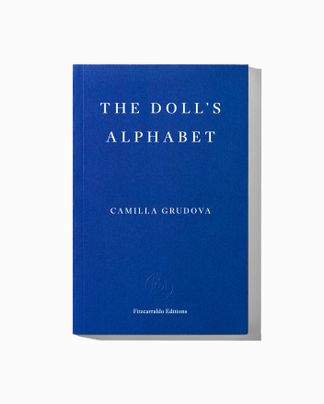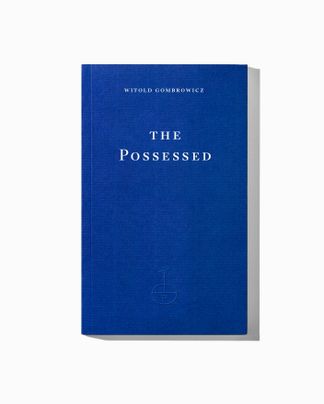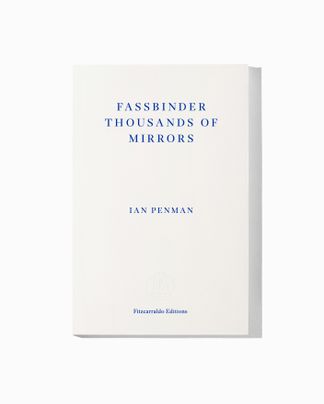This Young Monster is a hallucinatory celebration of artists who raise hell, transform their bodies, anger their elders and show their audience dark, disturbing things. What does it mean to be a freak? Why might we be wise to think of the present as a time of monstrosity? And how does the concept of the monster irradiate our thinking about queerness, disability, children and adolescents? From Twin Peaks to Leigh Bowery, Harmony Korine to Alice in Wonderland, This Young Monster gets high on a whole range of riotous art as its voice and form shape-shift, all in the name of dealing with the strange wonders of what Nabokov once called ‘monsterhood’. Ready or not, here they come…

This Young Monster
French paperback with flaps, 272 pages
Published 22 February 2017 (UK) | 6 June 2018 (US)
This Young Monster
SELF-PORTRAIT AS A WEREWOLF
‘Are there many little boys who think they are a monster?’
— Anne Carson
Hey Beast,
There’s a scary picture I want to show you: three kids outside their house, all wearing masks and grinning like devils. One has a crocodile head, another is a cartoon dog covered with funky spots and the last wears a deranged face drawn on a paper bag, eyes bugged, mouth crammed with jackal teeth. They’re dead now. They appear in this book called Haunted Air (2010) collecting old American pictures by anonymous photographers of folk in costume on Halloween. I’m guessing from the fuzziness of the picture that it must have been taken in the 1930s, roughly aligning with the time that Judy Garland crash-landed in Oz. There are tons of other pictures I could have fetched for you – David Bowie on the cover of Diamond Dogs (1974), half-alien, half-hound – or the Count’s shadow climbing the stairs from Nosferatu (1922), but beginning on Halloween seemed like the most potent clue to the festivities up ahead. Ghosts run amok, identities melt, everybody’s in costume, and reality is nowhere to be found. Think of it as an invitation asking you, as Captain Beefheart once howled, ‘to come out and meet the monster tonight!’
You’re one of the first monsters I remember meeting, both as a cartoon in Disney’s Beauty and the Beast (1991) and in huge illustrated books where you were usually depicted with a touch of the owl or hog. Almost everybody, if they’re lucky, sees monsters for the first time in fairy tales where the traditional response to their appearanceis astonishment. When the Evil Queen in Snow White and The Seven Dwarfs (1937) changes into a witch thanks to her psychotropic potion, even her beloved raven leaps back in fright and hides inside a skull by her cauldron until he’s just an eyeball, panicky, staring out of somebody else’s head.
Scary pictures were one of my earliest obsessions and I’ll try to explain why later on in this dumb fan letter to you, dear Beast. I don’t have a picture of myself to hand: not the snapshot in which I appear wearing a werewolf mask as a small boy on my birthday, or the other where I’m a vampire stalking through wet grass, sun low and red, squinting like a drunk through slender trees. I was a woozy child, the world was slow, it was fun to watch myself disappear in the mirror, face turning full moon white with make-up, fake blood drooling sweetly from my mouth, a little black crayon around the eyes for that buried alive stare: that was my face and yet it was not. When I discovered a new monster lurking in the forest of a film history book – David Naughton in An American Werewolf in London (1981), gazing at the hand that’s no longer quite his own, or Lon Chaney as The Phantom of the Opera (1925), gaunt and scalded by acid – I felt the same shiver: fear speedballing with wonder. I was electrified inside. That was the monster feeling.
Right now, of course, there are monstrous entertainments everywhere. Check the data: ‘ghost drone’ videos on YouTube (military tech enlisted to spook trick-or-treaters on Halloween); sell-out exhibitions dedicated to Alexander McQueen at the Met in New York and the Victoria & Albert Museum in London; the pop cultural ubiquity of zombies who now have their own parades in cities worldwide; the enormous success of the television series Stranger Things (2016), in which a bloodthirstyalien known only as ‘The Monster’ prowls 1980s suburbia; FKA Twigs videos, especially ‘Water Me’ (2014), directed by Jesse Kanda, where the singer is turned into a post-human doll sprung from the uncanny valley; and Oneohtrix Point Never’s album Garden of Delete (2015), conjuring puberty as a nightmare state through scrambled fragments of heavy metal, noise and electronic dance music, or its artwork showing a pre-teen boy, mid-scream, his liquid flesh melting away to reveal a robotic eyeball, synthetic teeth and bone.*
The abundance of monsters in circulation now proves that the collective imagination is in a strange and disorientating state, at once fearful of what can be done to the body through technology or trauma and fascinated by the possibilities those changes represent. In our present situation, dude, this seems like a good moment to go back, rewind, assemble some sort of history of monstrous wunderkinds and refract the present through them to mind-altering effect. If the monster is so now, it’s also one of art’s oldest inventions: there could be no other classification for the hydra killed by Hercules. If I was making a taxonomy, I’d keep you in the same group (‘Mythological Monsters’) though you don’t have the same connections to antiquity as the serpent or the maenads who slaughtered Orpheus and, through godly punishment, were transformed into shrieking trees. Then there are the new versions of old monsters like the grunge werewolves or vampires seen in Buffy the Vampire Slayer (1997-2003), which I was obsessed with in childhood and haven’t stopped thinking about since – Buffy uses supernatural metaphors to deal with real horrors so skilfully (all lovers are vampires) – and the contemporary monsters responsible for hideous deeds that still excite a slimy fascination. Check this recent newsflash, Beast: ‘Following the killing, the teenage couple took a bath to wash off the blood, had sex and watched four Twilight vampire films, abandoning plans to kill themselves’. (‘What if I’m not the hero? What if I’m the bad guy?’ as Robert Pattinson asks in the first movie when he’s playing Edward, the hot young bloodsucker.) And the body can be mutilated by accident or from birth and assume a monstrous condition. I’ve spent plenty of time reading and re-reading testimony from the woman who received the first facial transplant in 2005 (she was mauled by her dog, which was trying to rouse her from an overdose of sleeping pills) who said, of the months before the operation, that she had ‘the face of a monster’. ‘She had no mouth’, a report continues, ‘and her teeth and gums were exposed, skull-like.’
* FYI, sir, Stranger Things is the most mainstream symptom of a fascination with 1980s horror that’s haunted pop culture for the last decade or more. Boutique labels such as Death Waltz and Waxwork deal exclusively in reissuing the soundtracks to the era’s horror flicks on vinyl in luxurious packaging whilst an ongoing plague of remake mania afflicts old favourites such as Friday the 13th (1980; 2009), A Nightmare on Elm Street (1984; 2010) or Poltergeist (1982; 2015). This vogue might be due to nostalgia for the last era when monsters were neither slick digital chimeras nor ghost train squeaks in the dark (see the franchise horror of Paranormal Activity, 2007- or REC, 2007-2014) but flesh-and-blood bogeymen working in prosthetics and costumes, and thus imbued with villainous charisma. Or it may be another sign of a present cultural moment all about time warps and revivals, either demonically (re)possessing material from the past or bringing it back from the dead.
Yet there’s also the feeling, brought to life throughout Stranger Things and creepily barfed back up in its closing moments, that what’s really pined for is the ultra-cosy depiction of American home life that predominates in those movies just before the monster appears, as if the originals weren’t always rancid with irony.
(…)
‘My friend Bruce Hainley had told me about a new book coming out called “This Young Monster,” by Charlie Fox, but I had forgotten all about it until the publisher Fitzcarraldo Editions in London sent me this beautifully designed French-flap-style paperback original. Good God, where did this wise-beyond-his-years 25-year-old critic’s voice come from? His breath of proudly putrefied air is really something to behold. Finally, a new Parker Tyler is on the scene. Yep. Mr. Fox is the real thing.’
— John Waters, New York Times
‘This Young Monster is a hybrid animal in its own right, suturing biographical essays with stranger things: a “dumb fan letter” to the Beast, a meandering confession from Alice, bombed out after her many years in Wonderland…. There’s not enough of this sort of playfulness and frank enthusiasm in art criticism.’
— Olivia Laing, New Statesman
‘Surreal and provocative, This Young Monster is both a poignant portrayal of life on the margins, and a joyful salute to a group of people who embraced their misfit status to lead beautifully unconventional lives.’
— Lucy Watson, Financial Times
‘A Rimbaud-like moonbeam in written form.’
— Bruce Hainley, author of Under the Sign of [sic]
‘Charlie Fox writes about scary and fabulous monsters, but he really writes about culture, which is the monster’s best and only escape. He is a dazzling writer, unbelievably erudite, and this book is a pleasure to read. Fox’s essays spin out across galaxies of knowledge. Domesticating the difficult, he invites us as his readers to become monsters as well.’
— Chris Kraus, author of I Love Dick
‘A performance as original and audacious as any of the characters within – it crackles off the page, roaring and clawing its way into the world, powered by a brilliant vagabond electricity.’
— Chloe Aridjis, author of Book of Clouds
‘Charlie Fox is a ferociously gifted critic, whose prose, like a punk Walter Pater’s, attains pure flame. Fox’s sentences, never “matchy-matchy”, clash with orthodoxy; I love how extravagantly he leaps between different cultural climes, and how intemperately – and with what impressive erudition! – he pledges allegiance to perversity. Take This Young Monster with you to a desert island; his bons mots will supply you with all the protein you need.’
— Wayne Koestenbaum, author of Humiliation
‘Charlie Fox has a cardsharp’s diamond-eye for cataloguing the shapeshifting face of the sublime. His essays slither through skins over the warm flesh where so many mythic worlds and realities connect, from that of Twin Peaks to Diane Arbus, Fassbinder to Columbine, which somehow in their amassment ventriloquise a tender, enchanted endnotes for our black present. Put on this mask and breathe.’
— Blake Butler, author of 300,000,000
‘Central to the book is the corporeal home in which we find ourselves, the alien feelings that occur in an obstinate body and the forms of expression born of this contradiction. Fox writes as a surrealist conversationalist. At times the reader is invited to perform a role, somewhere between ventriloquist and historian, talking yourself into a beast.’
— Tank Magazine
‘[This Young Monster] is a paean to the queer transformative power of art.’
— Mònica Tomàs White, Totally Dublin
Charlie Fox is a writer who lives in London. He was born in 1991. His work has appeared in many publications including frieze, Cabinet, Sight & Sound, ArtReview, The Wire and The White Review.





